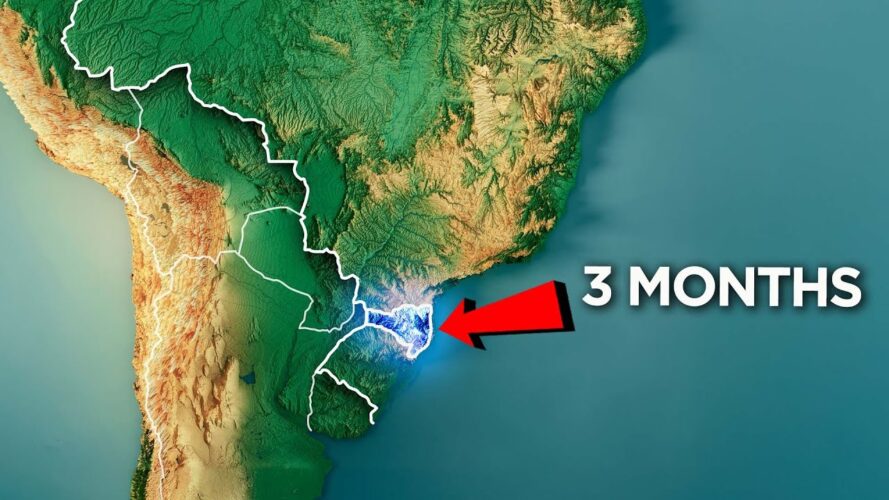History tells us that every country falls – eventually. Some manage to adapt and change over time and keep the same identity over centuries, but some… well they just weren’t long for this world. Today we’re going to examine the shortest-lived countries in history, which is actually a lot more complicated than it sounds.
TRANSCRIPT:
In the United States, we have an amusement park called Six Flags, there are many of them around North America but the first one was right here in Texas, which is how it got its name.
It’s said that Texas has had six flags flown over it going back to the Spanish in 1519. Of course there were indigenous people who ran this place for thousands of years before that but… They didn’t have a flag.
One of those flags by the way is the confederate flag so if you’ve ever had fun at a Six Flags… Do better.
But another of those flags is of course the Texas flag because as anybody from Texas will shout from the rooftops, we were once our own country.
What they usually don’t point out is that it only lasted nine years. It… wasn’t a huge success.
Friends lasted longer than the Republic of Texas.
But Texas isn’t unique. History is littered with countries who didn’t make it that long. Hell there are countries who didn’t last as long as Automan.
So today we’re going to explore the weird history of short-lived countries, including one that only lasted 15 minutes.
What is a Country?
Of course the first step in picking the shortest-lived countries is to be pedantic and ask the obvious question… what is a country?
It’s not as easy to answer as you might think.
We tend to think of countries as places on a map. But as I’ve found many times on this channel, maps can be quite contested.
A YouTuber friend of mine one time said that “all maps are politics.” And holy crap that’s true.
I’m thinking of the time I did a video about the Artemis Accords and we used an map from Wikipedia that showed all the participating countries. And whoever made this map included Crimea as part of Russia. (beat) That did not go over well.
Had several comments calling me a shill for Putin. Which I find deeply offensive. You really think that’s the hardest I could sell out? Give me some credit.
But it proves the point that there are a lot of contested places in the world, including countries that consider themselves independent while another country claims ownership of that territory.
Taiwan, both Koreas, and Northern Cyprus are all examples.
Same with Israel and Palestine, which, you may have heard about.
I mean technically, anybody can declare themselves a country, but just declaring something doesn’t make it true.
I mean, hell I could declare this room its own country.
All rise for the singing of our National Anthem:
”My Zoe ‘tis of thee
Sweet land of bulldog farts…”
There are a couple of theories around what defines a country, one is called Declarative Theory, and the other is Constitutive Theory.
Declarative Theory goes back to 1933, at a meeting of North and South American nations in Montevideo, Uruguay.
According to it, a “state” — which I’m going to use as a synonym for country — has all of the following:
- A defined territory,
- Permanent population,
- A government
- The capacity to enter into relations with other states
The other big one, the constitutive theory basically says you’re a country if other countries agree
A Working Definition
But for the purposes of this video, I’m going to use a variant on the declarative theory and narrow it down to three things:
- Holds territory with a defined border, even if that border is contested
- Has a functioning government and/or constitution
- Is populated by a distinct people that recognize the government
And yeah, this is an oversimplified, very loose definition, I’m not trying to give an international law class here. No need to get bogged down in the details, this is just a fun YouTube video.
Also I left off the foreign relations bit because those things take time, and many of these countries just weren’t around long enough to make that happen.
On South Sudan
By the way, if you’re wondering what the current youngest country in the world is right now, it’s South Sudan, who will turn 14 this year.
South Sudan split from Sudan after suffering through two civil wars, the last of which ran all the way from 1983 to 2005
A 2005 peace agreement paved the way for the division, but their independence was achieved on July 9th, 2011. South Sudan was accepted as a UN member five days later
Unfortunately the ethnic conflict that led to the split has continued to happen, in fact, they almost immediately entered in a new civil war in 2013.
By the time it ended in 2020, around 400,000 people had been killed and 4 million others displaced from their homes, according to the UN.
As of last year, around half of South Sudan’s 12.4 million people are facing a hunger crisis. So, there’s still a ways to go.
And that’s not uncommon. Everybody wants a revolution, but nobody wants the civil war that almost always follows.
All of which is to say that, while this is just a fun video about short-lived countries, the turmoil that created these countries is real, and affects thousands of real people.
Just something to keep in mind.
Republic of Ezo
On that note, let’s jump into our first story, the Republic of Ezo.
The Tokugawa shogunate ruled Japan from 1603 to 1869
A shogun is essentially a military dictator, so not a guy you expect to go quietly when he’s overthrown
In 1854, the US Navy forced the Japanese to open their ports, which had been closed to foreigners
That combined with pressure for the country to modernize led to political turmoil that resulted in the last shogun stepping down. His name was Tokugawa Yoshinobu, and he was succeeded by a new emperor from a new family named Meiji.
Meiji was 15 years old.
With a kid on the throne, the Tokugawa family remained influential, and naturally they had enemies. Some of those enemies weren’t content with him just resigning, they wanted Yoshinobu to be stripped of his lands.
They started burning down his castles, he retaliated, it became a giant mess that’s now called the Boshin War.
This was a really interesting time in Japan’s history, because they had samurai, dressed in traditional samurai armor and swords, also fighting with rifles and artillery.
While other armies wore western-style military uniforms and gear.
Some even wore long wigs of different colors that showed where they came from. Seriously, it was a wild time.
Eventually, Yoshinobu surrendered, but his allies kept up the fight, led by a navy admiral named Enomoto Takeaki.
At the beginning of 1869, Takeaki took control of Japan’s second-largest island, Hokkaido. Which was called Ezo at the time.
And there they declared their independence and established their own country, calling it the Republic of Ezo. With Takeaki as the president.
They chose to follow models of France and America, so it was democratic, it was a republic.
Was it Ben Franklin who said, “A republic, if you can keep it.”
They did not keep it.
The Republic of Ezo was established in January 1869, and it dissolved in June that same year.
That was when the Imperial navy and 7000 ground troops reconquered Ezo island.
This solidified the power of the Empire of Japan, which would rule until the end of World War II in 1945. After which Japan would become a democracy. So you could argue that the Republic of Ezo was just ahead of the curve.
Interestingly, the survivors of the revolution did alright after it was crushed
Yoshinobu Tokugawa went into a long, peaceful retirement
Enomoto Takeaki did time in prison but then was forgiven and went back to the navy, even serving as Navy Minister for a time
The Juliana Republic
This next one was also started by a civil war, this time in Brazil, and it was called the Juliana Republic.
The Brazilian civil war took place from 1835-1845, and it was fought between the Imperial Brazilian Army and a rebel group that called themselves the Farrapos.
Farrapos is the Portuguese word for the leather fringes they wore on their clothes. But it can also be translated to English as “ragamuffins.” So the conflict is sometimes called The Ragamuffin War.
The basis for the conflict was mostly economical. The farrapos were ranch owners who wanted control of southern Brazil’s meat market
The Brazilian government on the other hand, wanted to allow foreign competition
For this and other reasons, the farrapos campaigned to replace the Empire with a representational form of government
Now, I should mention that slavery was also an issue in the war
The farrapos promised freedom to African slaves in their part of Brazil
But before you start cheering for those guys, well… wait for it.
On July 22, 1839, ragamuffin rebels captured the city of Laguna in the modern state of Santa Catarina, and they declared independence on July 29, forming the Juliana Republic.
And there are different explanations for why they called it this, the obvious one is that it was named for the month it was founded. Kinda makes you suspect they weren’t thinking long-term.
I mean the guy they elected as president wasn’t even able to take office because of an imperial blockade. It was pretty much doomed from the start.
After less than 4 months, Laguna was retaken by the Imperial army. And that was the end of the Juliana Republic.
But it was not the end of the Ragamuffin War, that came five-and-a-half years later, in March 1845. And the ending wasn’t pretty.
So by that point, the ragamuffin army was down to a few tatters, and the last hangers-on were camped on a hill called Cerro dos Porongos, and the Imperial army was closing in on them.
And the thing about the farrapos were they were abolitionists – they wanted to end slavery – but they had segregated camps.
There was a black camp and an everybody else camp.
So as the Imperial Army was poised to attack, supposedly, the farrapos commander sent a letter to the other side saying hey, if you’re going to attack… maybe just attack those guys.
And then he moved his camp further away to avoid the conflict.
Because of that, 95 of the 150 black soldiers were killed in what is now called the Porongo Massacre.
Now there is debate around whether or not that letter was genuine. Some think it really came from the farrapos commander, in an attempt to spare the people of “Brazilian Blood” – meaning whites and Indians.
But there are some who think that the letter was forged by the Brazilian side to foment division amongst the rebels.
Regardless, after the war, some Black soldiers were re-enslaved, others escaped. Some farrapos objected and continued the fight to end slavery, but it wasn’t enough to bring about change.
It took until 1888 for Brazil to be become the last country in the Americas to outlaw slavery.
This was 49 years after the Juliana Republic came and went, lasting for only 4 months.
Provisional Government of Saskatchewan
Alright, so far we’ve heard about governments that lasted five and four months respectively
This next one breaks the pattern by lasting just under two months
We’re still in the Americas for this one, but now way up north
In 1885, indigenous leader and mustache icon Louis Riel declared part of Canada’s North-west Territories independent
The disputed region, which was ruled by a governing council, became known as Gouvernement provisoire de la Saskatchewan
In English, that’s the Provisional Government of Saskatchewan
The founder, Louis Riel, was quite a character
At age 25, he spoke out against a plan to conduct a land survey that would lock in Canada’s control of what is now Manitoba, Saskatchewan, and Alberta
He followed this up with physical resistance
When the Red River Métis people organized to oppose the survey, Riel was made secretary of their National Committee
He soon became leader of a provisional government, but not the one we’re talking about
I bring this earlier government up because while Riel was in charge of it, an enemy of the provisional government was put on trial and executed
Eventually, the Canadian government made peace with the Métis
Riel remained a controversial figure.
He was elected to the Canadian Parliament twice but never served because he would be tried for the murder of the executed man
Eventually, he moved to New York and started a family
At the age of forty, he was called back to Saskatchewan by his former allies
They started a rebellion and Riel declared his new provisional government was a thing
When the Canadian army showed up, Riel’s forces fought a brief guerilla war
Ultimately, they were swept aside by a vastly superior force
Riel himself was brought to trial for treason
He rejected a plea of insanity and was found guilty
At the age of 41, Louis Riel was hanged
The Provisional Government of Saskatchewan he founded lasted for a total of 53 days, from March 19 to May 20, 1885.
The Palmetto Republic
I can’t talk about civil wars and short-lived countries without mentioning the secession of Southern US states
The Confederate States of America lasted far too long to be mentioned on today’s list
But it wasn’t the only “country” by my definition to spin out of the US Civil War
The Palmetto Republic was first
That’s a nickname for post-secession South Carolina
SC was the first state to secede after Abraham Lincoln was elected president
Politicians discussed the the idea of secession in November 1860 while James Buchanan was still serving as a lame duck
On December 20, 1860, South Carolina declared its secession from the Union
They adopted a new flag and a coat of arms
Both of these showed the palmetto tree, which explains the nickname
Less than a week after the secession, the US army commander in South Carolina retreated to Fort Sumter, an island off the coast
Militia aimed guns at them and in January 1861, forced a US supply ship to retreat
By shooting it, in case you were wondering
As you’d expect, both US presidents involved, Buchanan and Lincoln, were perturbed by this
South Carolina knew it couldn’t take on the whole country alone so asked other slave-owning states to help
Six states agreed and joined South Carolina to form the Confederacy on February 8, 1861
A total of eleven states were eventually involved in the Confederacy
But relevant to this list, South Carolina stood alone from December 20, 1860 through February 8, 1861
That’s a total of 50 days.
Russian Democratic Federative Republic
I’m going to admit up front that the last entry on this list of short-lived countries is a bit of a cheat
Like I said from the outset, which countries count depends on definitions
None on this list stretch the definition more than this one
The Russian Democratic Federative Republic was a country with a huge territory, millions of citizens, and all the powers of an independent nation
And it lasted less than a day
Kind of…here’s the story in brief
On March 2, 1917 Tsar Nicholas II of Russia abdicated his throne
A provisional government was immediately set up that ruled the country for eight months
Six months into its rule, the provisional government moved to create the Russian Republic, a. k. a. the Russian Democratic Federative Republic
So you could kind of say that the short-lived country existed from that point on
Thing is, it didn’t actually take over ruling
The provisional government continued to operate
As anyone who paid really good attention to Doctor Zhivago can tell you, Bolshevik leaders cooperated with other political entities in Russia for a little while after gaining power
That ended in October 1917 when they pushed out the other guys and took over
In November 1917, the Bolsheviks dissolved the provisional government but they still allowed elections arranged prior to happen
On January 18, 1918 the elected officials said, “Hey guys! We’re a new country!”
They called that country the Russian Republic, just like the provisional government did back in September
Later that same day, the Bolsheviks decided they didn’t like where things were headed, so they dissolved the elected assembly
So, you could argue the Russian Democratic Federative Republic existed from September 1917 until January the next year, or that it existed only on January 18th
Take your pick.
Either way, the birth and more-so death of this short-lived country impacted the lives of millions of people for generations to come.
Republic of Texas Redux
Sometimes when I read history I shake my head at how quickly conflicts can turn into crises
Then I remember I’m living in history right now
The divisions that rock our world today aren’t that different than the ones that broke apart countries in the past
Like I said in the intro, Texans are quite proud of the fact that we used to be our own country. So proud, in fact that there’s a not insignificant number of people who want to do it again.
They call it Texit – an obvious nod to Brexit in the UK – and it isn’t just talk, as recently as 2023 there were actual bills being discussed in Austin to break Texas away from the US. Some people are very serious about this.
I do like to point out to people though that if Texas left the US and took their 34 electoral votes with it, there probably wouldn’t be another Republican president for a very long time. Just saying.
But so what, Texas be crazy you may be saying. Well we’re not alone.
There are secessionist movements all over the place in North America, from neo-confederates who want the south to rise again, to a California independence movement, Vermont has a strong independence movement, Alaska, Florida has an independence party. And then there’s the Conch Republic people in the Florida Keys.
There’s a movement to split off a country called Cascadia, made up of Washington, Oregon, part of northern California, and British Columbia.
Speaking of Canada, Alberta has a strong independence movement, Saskatchewan has winked toward independence, and don’t get me started on Quebec.
The Zapatistas in Mexico have a de facto autonomous zone that they want to split off to be their own country, and multiple indigenous groups are arguing for independence in all three countries.
And all that’s just in North America, this going on all over the world, basically any place people disagree, there’s a movement to make them their own country. It’s just kind-of a thing that people do.
Luckily most of these don’t descend into outright violence and civil war. But it obviously does happen. Far too often, really.
So maybe if you’re looking for a job with future prospects, maybe consider mapmaking. Because they are going to keep changing.




Add comment